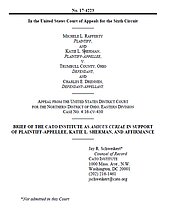When Katie Sherman was nineteen years old, she was incarcerated at Trumbull County jail in Ohio, for about five months. During that time, Charles Drennen worked as a corrections officer in the female pod of the jail where she was housed. Several female inmates had filed complaints that they had been harassed and threatened by Drennen, who had a reputation for glaring at the inmates while they were sleeping, but Drennen began focusing on Ms. Sherman in particular. He constantly made highly sexual comments to her, and on at least four or five occasions, ordered her to expose herself to him, and to sexually touch herself in front of him and other inmates. Ms. Sherman — a nineteen-year-old girl — complied because she was intimidated by Drennen. She eventually attempted to file a complaint against him (even though complaints were not anonymous), but she was never given the complaint form she requested.
After she was released, Mr. Sherman (along with Michele Rafferty, her cellmate) filed a Section 1983 claim, asserting (amongst many other claims) that Drennen’s sexual abuse violated her Eighth Amendment right to be free from cruel and unusual punishment. Drennen moved for summary judgment, making the incredible claim that because he did not physically touch Ms. Sherman himself, he should receive qualified immunity for any violation of her rights. The district court correctly rejected this perverse “no touching” safe harbor for sexual abuse, and held that Ms. Sherman could proceed to trial on her constitutional claim. But qualified-immunity doctrine gives defendants a one-side litigation advantage in the form of interlocutory appeals, so Drennen immediately appealed the denial of immunity to the Sixth Circuit, before the case could even go to trial.
The Cato Institute has thus filed an amicus brief with the Sixth Circuit, urging the court to affirm the denial of immunity, but also to address the legal infirmities with the doctrine in general. Qualified immunity was essentially invented out of whole cloth by the Supreme Court over the last half century. The text of our primary civil rights statute — usually called “Section 1983” after its place in the federal code — makes no mention of any immunity, and the common-law background against which it was adopted did not include any freestanding defense for public officials who acted unlawfully; on the contrary, the historical rule was that public officials were strictly liable for constitutional violations. In essence, qualified immunity has become nothing more than a “freewheeling policy choice” by the Court, at odds with Congress’s judgment in enacting Section 1983.
This brief is part of Cato’s ongoing campaign to demonstrate that qualified immunity lacks any legal basis, vitiates the power of individuals to vindicate their constitutional rights, and contributes to a culture of near-zero accountability for law enforcement, prison personnel, and other public officials.

